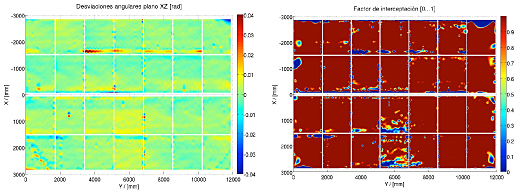

GeoLab
Geometrical characterization of solar concentrators
LThe concentrators used in solar thermal systems (heliostats, parabolic-trough collectors, parabolic dishes, Fresnel lenses, etc.) require high precision concentration of the solar radiation for it to be suitable and most of it incident on the receiver component (receiver tubes in parabolic-trough collectors, receivers in tower systems, parabolic dishes, Fresnel lenses, etc.). The laboratory of the Concentrating Solar Systems Unit has a specific activity line for the geometric characterization of these concentrators. Photogrammetry is used to quantify the optical quality of:
- Parabolic-trough collector facets
- Parabolic-trough collector modules
- Heliostat facets
- Heliostats
- Fresnel lenses and reflectors
- Parabolic dishes
- Structural frames
- Etc.
Photogrammetry consists of three-dimensional modelling of any object from photographs that capture it from different angles. Based on these photographs, the three-dimensional coordinates (x, y, z) can be calculated for the points of interest on the object being modelled. Photogrammetry modelling is precise up to 1:50000 (precisions on the order of 0.1 mm for parabolic-trough collector facets and 0.6-0.7 mm for 12-m-long parabolic-trough modules).

The equipment allocated to this activity at PSA is composed of:
- CANON EOS5D MarkII 22-Mpixel Camera.
- CANON EF 20mm f/2.8 USM and CANON EF 24mm f/2.8 USM lenses.
- Photomodeler Scanner 2012 photogrammetry software.
Additionally, a software package for model analysis and calculation of relevant parameters for 2D and 3D geometries in the MatLab environment has been developed in house.
Among the parameters that can be calculated from the model built by photogrammetry are:
- Deviations of real from theoretical surface on coordinates x, y, z.
- Gravity deformation between different concentrator orientations.
- Angular deviation from the normal vector to the surface compared to the theoretical normal vector.
- Deviation of reflected rays on the reflective surface of the module compared to the theoretical concentrator focus.
- Intercept factor.
- (Calculation of other relevant parameters by request).